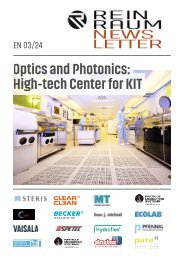Newsletter_07-2024_EN
You also want an ePaper? Increase the reach of your titles
YUMPU automatically turns print PDFs into web optimized ePapers that Google loves.
On-chip flow cytometer using integrated photonics paves the way<br />
for high-throughput cell analysis<br />
Scalable on-chip detection of<br />
human white blood cells<br />
Imec, a world-leading research and innovation hub in nanoelectronics<br />
and digital technologies, and Sarcura GmbH, an Austrian<br />
early-stage technology start-up, present their proof-of-concept<br />
on-chip flow cytometer using integrated photonics. Published on<br />
20th May <strong>2024</strong> in Scientific Reports, part of the Nature Publishing<br />
Group, this innovation offers a unique platform for the detection<br />
and discrimination of human leukocytes and marks a significant<br />
stride towards cost-effective, scalable, and highly parallelized cell<br />
analysis.<br />
Accurate identification of human cells is a<br />
key operation in modern medicine, pivotal<br />
for understanding disease mechanisms and<br />
advancing targeted and personalized treatments.<br />
With the advent of cell manufacturing,<br />
living cells can now be engineered to<br />
function as treatments, notably in groundbreaking<br />
therapies like CAR-T immune cell<br />
therapy for cancer. The ability to identify<br />
these therapeutic cells in complex cell products<br />
at high throughput is crucial, and often<br />
time sensitive.<br />
The method of choice today is flow cytometry,<br />
which enables characterization of<br />
cell populations based on the physical and<br />
chemical characteristics of individual cells<br />
as they flow past a laser. However, the current<br />
implementation include bulky instrumentation,<br />
complex and manual workflows<br />
(posing contamination risks), and high<br />
operational costs. These challenges hinder<br />
widespread availability and adoption of cell<br />
therapies in decentralized settings.<br />
To address these limitations, imec<br />
harnesses its expertise in CMOS<br />
technology, photonics, and fluidics to<br />
automate, miniaturize and parallelize flow<br />
cytometry. In a study published in Scientific<br />
Reports imec, together with Sarcura, unveils<br />
an on-chip flow cytometer using integrated<br />
photonics. Fabricated on imec’s 200mm<br />
CMOS pilot line, the opto-fluidic chip features<br />
a pioneering material stack facilitating<br />
both cell illumination and capturing of scattered<br />
light through waveguide optics, and<br />
precise cell delivery to the detection points<br />
using microfluidic channels.<br />
“Silicon photonics, as successfully demonstrated<br />
in this novel photonic chip, is<br />
the revolutionary and essential building<br />
block that merges single-cell detection capabilities<br />
with massive parallelization on<br />
a dramatically miniaturized footprint. This<br />
breakthrough opens new possibilities for<br />
addressing previously unsolved challenges<br />
in applications such as cell therapy manu-<br />
Figure 2: (Left) Schematic cross-section of the chip layer stack, indicating light coupling<br />
into the chip, cell illumination, and collection and detection of cell scattering signals.<br />
(Right) Experimental scatter plot of a full peripheral blood mononuclear sample<br />
measured with the on-chip flow cytometer.<br />
Figure 1: Picture of the on-chip flow cytometer.<br />
facturing,“ states Daniela Buchmayr, CEO<br />
and Co-founder of Sarcura.<br />
Niels Verellen, Scientific Director at<br />
imec, remarked, “We have demonstrated,<br />
for the first time, that a monolithically integrated<br />
biophotonic chip can be used to collect<br />
optical scattering signals that allow the<br />
discrimination of lymphocytes and monocytes<br />
from a patient’s blood sample, rivaling<br />
the performance of commercial cytometers.<br />
The main advantage lies in the potential for<br />
dense parallelization of multiple flow channels<br />
to boost the system throughput.” In a<br />
next phase, the compact, alignment-free<br />
design should enable billions of cells to be<br />
identified within a limited amount of time.<br />
Crucially, the chip architecture seamlessly<br />
integrates with imec’s previously<br />
developed bubble jet cell sorting module,<br />
compatible with wafer-scale fabrication.<br />
Furthermore, the photonic components and<br />
layout can be tailored to suit specific applications.<br />
This proof-of-concept therefore<br />
marks a substantial leap towards cost-effective,<br />
scalable, and highly parallelized cell<br />
sorting platforms.<br />
IMEC Belgium<br />
BL 3001 Leuven<br />
www.reinraum.de | www.cleanroom-online.com NEWSLETTER | Edition <strong>EN</strong> <strong>07</strong>-<strong>2024</strong><br />
page 20/28
















